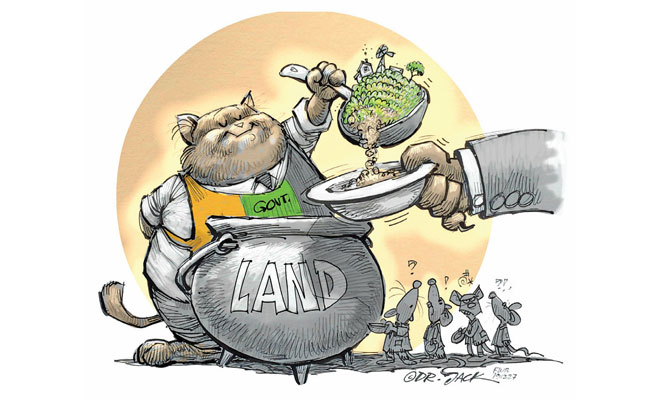
Currently, land reform beneficiaries gain access to land through the leasehold system introduced by the Proactive Land Acquisition Strategy (PLAS) in 2006, and put into operation by the State Land Lease and Disposal Policy (SLLDP) of 2013 (revised in 2019).
But land reform governance is weak and there is a lack of transparency and accountability. Indeed, research undertaken by the Institute for Poverty, Land and Agrarian Studies shows that elite capture of public resources in land reform is on the rise.
Elite capture occurs when “resources transferred for the benefit of the masses are usurped by a few, usually politically connected and/or economically powerful groups, at the expense of the less economically and/or politically influential groups”.
The process unfolds at various points within the land reform process due to a number of factors. These include manipulative practices where different actors exploit policy ambiguities and institutional weaknesses, and implicit and explicit forms of corruption, nepotism and rent-seeking practices.
SLLDP policy broadly identifies “those who are racially classified as African, Coloured and Indian” as the “historically disadvantaged persons” to be prioritised as beneficiaries. However, as it now stands, the category includes state bureaucrats and well-off beneficiaries with privileged access to material resources, knowledge and information.
For farmworkers, labour tenants, the landless, marginalised women and youth, and smallholders, equitable access to land, as required by Section 25 (5) of the Constitution, has been elusive.
Over time, government has also placed greater emphasis on viable business plans, production targets and profitability at the expense of social justice and equity imperatives.
There is no willingness to subdivide large farms and accommodate smallholder farming within SLLDP. Instead, there is bias towards large-scale commercial farming.
Most of the farms included in the study were allocated to men (81%), while only a few had women as beneficiaries (19%).
This is contrary to government’s commitment to gender equality. Only 15% of the farms were allocated to the ‘rural poor’ (or farmworker beneficiaries). These are a priority category in policy, and make up a significant proportion of the rural poor.
Some 44% of the farms were allocated to well-off business people diversifying into farming. They already had access to their own capital resources outside of agriculture.
At least 45% of beneficiaries have no valid leases. These farms have thus not actually been legally redistributed, in the sense that property rights to them have not been transferred.
The beneficiaries have no secure land rights or leases to confirm their occupation of the land.
It was further found that state bureaucrats and the politically powerful often capture resources in land reform through soliciting bribes, fronting, the imposition of politically connected beneficiaries, and bailing out politically connected people.
Agribusinesses also engage in ‘farm flipping’, the imposition of strategic partners and mentors, prioritising high-value crops at the expense of multiple livelihoods, and failing to declare dividends.
Recommendations
Some key recommendations are identified in the report:
- Promulgate a new land reform law to ensure equitable access to land. The focus should be on land rights, tenure security, and management of leases of land reform beneficiaries.
- Revise the category ‘historically disadvantaged groups’. Well-off beneficiaries continue to benefit disproportionately from the SLLDP programme on the basis that they are broadly part of historically disadvantaged groups. A more inclusive land redistribution programme would need to include farmworkers, labour tenants and communal area farmers.
- Ration the expenditure of public resources in land redistribution. The proposal in the presidential panel report to allocate 60% of the budget to smallholder producers and landless and land-poor households is a good solution. The remaining 40% of the land may be allocated to medium- and large-scale commercial producers.
- Promote gender equity. The inclusion of women is a prerequisite for equitable access to land as required by the Constitution.
- Rethink the leasehold system in land redistribution and ensure security of tenure. The high levels of tenure insecurity among the land reform beneficiaries have undermined the success of the programme in multiple ways.
- Develop stringent monitoring and evaluation of land reform programmes to enhance governance.
- Reconfigure land reform institutions to ensure greater coordination between land reform and agriculture components. The efforts to integrate key components of land reform and agriculture under the newly created Ministry of Agriculture, Land Reform and Rural Development are key to achieving policy coherence and coordination.
- Strategic partners, agribusinesses and mentors need to be monitored to ensure accountability in the use of recapitalisation funds meant for production or post-settlement support. Mentors and strategic partners wield disproportionate power to control the farming enterprises, often pursuing their own interests.
Social transformation
Commercial ‘viability’ cannot be the only basis for measuring success in land redistribution.
Policymakers and agricultural experts in land reform tend to emphasise the importance of productivity, especially increased production of marketed output.
These measures of success are narrow and exclusive. There should be more emphasis on
the role of land reform as a mechanism for social transformation by supporting household food security and multiple livelihoods among the poor.
In conclusion, the skewed distribution of resources in land reform in favour of well-off groups has impeded the realisation of equitable access to land in South Africa. Moreover, evidence suggests that under current conditions and existing practices, expropriation without compensation would similarly benefit the well-off at the expense of the poor.
For more information, read the report ‘Elite capture in land redistribution in South Africa’ (December 2019), by Farai Mtero, Nkanyiso Gumede and Katlego Ramantsima, published by the Institute for Poverty, Land and Agrarian Studies of the Faculty of Economic and Management Sciences, University of the Western Cape. This involved a study of seven sites in five provinces of South Africa (the Eastern Cape, Free State, KwaZulu-Natal, North West and the Western Cape). A total of 62 State Land Lease and Disposal Policy projects were investigated between May and November 2018.
The views expressed in our weekly opinion piece do not necessarily reflect those of Farmer’s Weekly.











